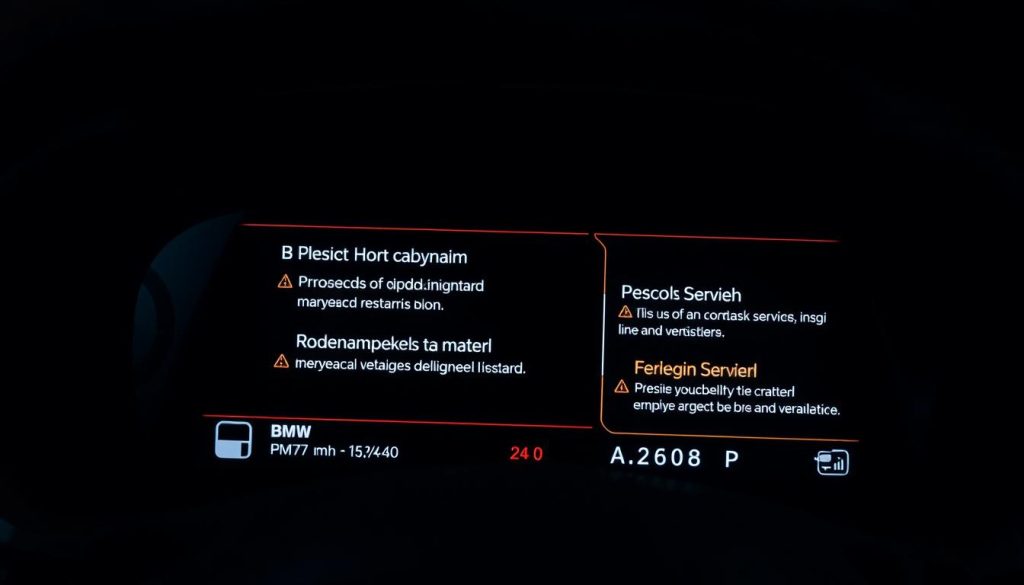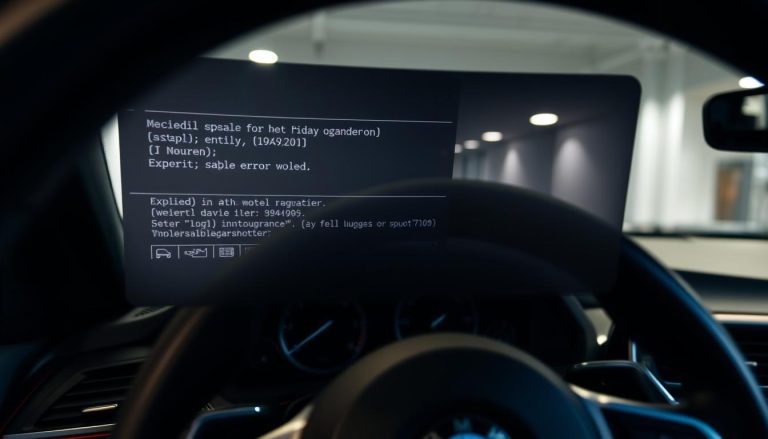The BMW emergency call system, a cornerstone of vehicular safety, automatically initiates contact with emergency services upon detecting an accident. Yet, malfunctions can occur, necessitating immediate resolution. If your BMW’s emergency call system is malfunctioning, swift action is imperative.
Experiencing a system failure can be distressing, but rectifying the issue is straightforward. By adhering to a few elementary steps, you can reset your BMW SOS system, ensuring its optimal functionality.
Key Takeaways
- Understand the importance of the BMW emergency call system
- Identify common errors that cause system failure
- Learn the simple steps to resolve BMW emergency call errors
- Reset your BMW SOS system with ease
- Ensure your safety on the road with a functioning emergency call system
Understanding BMW’s Emergency Call System
The BMW Emergency Call feature, commonly referred to as SOS, is engineered to offer immediate support in the aftermath of an accident. This system, a pivotal safety component, is integrated into a multitude of BMW models.
What is the BMW Emergency Call Feature?
The BMW Emergency Call feature constitutes an advanced safety mechanism, automatically notifying emergency services upon detection of a collision. Its primary objective is to expedite assistance, thus reducing response times and potentially averting fatalities. Activation can occur through manual engagement of the SOS button or automatically in the event of a severe impact.

How the System Works
The BMW Emergency Call System leverages GPS, cellular connectivity, and onboard sensors to identify accidents and alert emergency services. Upon accident detection, it dispatches a distress signal to BMW’s emergency response center. This center then initiates contact with local emergency services, ensuring prompt assistance. The system conveys vital information, including the vehicle’s precise location, to expedite the response process.
Common BMW Emergency Call Error Messages
Grasping the nuances of BMW’s emergency call system error messages is paramount for effective troubleshooting. These alerts signify a spectrum of malfunctions, ranging from minor to severe system failures. Such occurrences necessitate immediate attention to prevent potential risks.

SOS Emergency Call System Failure
The “SOS Emergency Call System Failure” alert heralds a critical malfunction in the emergency call system, a cornerstone of BMW’s safety features. This error signifies the system’s inability to initiate emergency calls, posing a significant risk to occupants in emergency situations. Urgent intervention by a BMW service center is imperative to rectify the issue and restore functionality.
Emergency Call System Limited Functionality
The “Emergency Call System Limited Functionality” notification indicates that, despite operational status, the system’s capabilities are curtailed. This limitation could stem from software malfunctions, network connectivity issues, or hardware defects. Drivers must exercise caution, as the system’s efficacy in emergency scenarios may be compromised.
Emergency Call System Unavailable
The “Emergency Call System Unavailable” message signifies a complete system failure. This could arise from SIM card malfunctions, antenna issues, or profound software glitches. In such instances, professional evaluation is critical to ensure the restoration of the vehicle’s safety functionalities.
BMW specialists underscore the importance of a functional emergency call system for safety. They emphasize the need for regular maintenance and prompt repairs to uphold this critical feature.
Why BMW Emergency Call Errors Occur
The dependability of the BMW emergency call system is susceptible to various impediments, encompassing software, network, and hardware malfunctions. Grasping these causative factors is imperative for the efficacious diagnosis and rectification of such issues.
Software Glitches
Software glitches frequently precipitate BMW emergency call system malfunctions. These glitches may stem from outdated software or inherent system programming bugs. Regular software updates are indispensable to avert such problems. In certain instances, a mere software update can rectify the error.
Network Connectivity Issues
The efficacy of the BMW emergency call system heavily relies on network connectivity. Disruptions in this connectivity can manifest as errors. Contributing factors include weak signal strength or problems with the network provider.
Hardware Malfunctions
Hardware malfunctions, albeit less frequent, can also induce emergency call system errors. Defects such as a faulty antenna or internal hardware malfunctions can impede the service’s functionality. A meticulous examination is necessary to pinpoint hardware-related anomalies.
| Cause | Description | Potential Solution |
|---|---|---|
| Software Glitches | Outdated software or programming bugs | Software update |
| Network Connectivity Issues | Poor signal strength or network provider issues | Check signal strength or contact network provider |
| Hardware Malfunctions | Faulty antenna or internal hardware issues | Inspect and repair or replace hardware |
Preparing to Reset Your BMW Emergency Call System
Initiating the reset of your BMW’s Emergency Call System necessitates thorough preparation. This step is paramount to ensure the process is executed with both efficiency and safety.
Tools You’ll Need
Several essential tools are required for the reset of your BMW’s Emergency Call System. These include a user manual for guidance, a phone with internet access to verify software updates, and possibly a multimeter for electrical connection verification. Having these tools at the ready will expedite the reset procedure.
Safety Precautions
When engaging with your vehicle’s systems, safety must be your paramount concern. It is imperative that your BMW is parked on a level surface and that the parking brake is applied. Ensure the ignition is off prior to commencing any work. Adhering to these safety precautions is crucial to avoid accidents or injuries during the reset process.
Step 1: Perform a Basic System Restart
Initiating a system restart is a fundamental yet efficacious method to rectify BMW Emergency Call Errors. This procedure entails a series of actions aimed at rebooting the system, potentially resolving the error at hand.
Turning the Ignition Off and On
The restart process commences with the ignition being turned off. It is imperative to confirm that the ignition is fully extinguished prior to proceeding. Subsequently, the ignition is reactivated. This initiates the reboot sequence.
“It’s crucial to allow the system to fully cycle through the restart process.” The ignition’s toggling off and on serves to refresh the system’s software, potentially eliminating any transient glitches.
Waiting for System Reboot
Following ignition reactivation, a brief interval is necessary to permit the system’s complete reboot. This waiting period is critical, as it affords the system ample time to restart its processes and potentially rectify the error.
Checking If Error Persists
Upon the system’s reboot, an assessment should be conducted to determine if the Emergency Call Error persists. If the error message continues to manifest, it may signify a more intricate issue necessitating further diagnostic endeavors.
As BMW experts advise, a simple restart often suffices to resolve the issue. Yet, persistent errors may necessitate additional diagnostic procedures.
Step 2: Reset the iDrive System
The iDrive system, pivotal for your BMW’s infotainment and connectivity, occasionally necessitates a reset to operate optimally. This reset can rectify software malfunctions that may be triggering the emergency call errors.
Accessing the iDrive Settings Menu
To initiate the reset procedure, accessing the iDrive settings menu is imperative. The steps to achieve this are as follows:
- Engage your BMW’s ignition.
- Activate the Menu button on your iDrive controller.
- Utilize the controller to navigate to Settings.
- Select System Settings or a comparable option, contingent upon your iDrive iteration.
Performing a Soft Reset
A soft reset constitutes a mild restart of the iDrive system, preserving your saved configurations. It serves as an initial solution to the emergency call error.
For BMW Models with iDrive 7.0
For iDrive 7.0, a soft reset is achieved by concurrently pressing and holding the Back button and the Volume control button for approximately 10 seconds.
For BMW Models with iDrive 6.0 and Earlier
In the case of earlier iterations, press and hold the Menu, Voice Command, and Back buttons simultaneously for 5-10 seconds.
Performing a Hard Reset
Should a soft reset fail to resolve the problem, a hard reset becomes necessary. This action will revert the iDrive system to its original factory settings, necessitating reconfiguration of your preferences.
| Reset Type | Effect on Settings | iDrive Version |
|---|---|---|
| Soft Reset | No loss of settings | iDrive 7.0, iDrive 6.0 |
| Hard Reset | Settings restored to factory defaults | iDrive 7.0, iDrive 6.0 |
Post-reset, verify if the emergency call error persists. If the issue continues, further action may be required.
Step 3: How to Reset BMW Emergency Call Errors Through Battery Disconnect
The third step in resolving BMW emergency call errors involves disconnecting the vehicle’s battery to reboot the system. This method is notably effective when other troubleshooting steps have failed to resolve the issue.
Locating Your BMW’s Battery
Before initiating the battery disconnection, it is imperative to identify the battery’s location within your BMW. The battery’s location can vary significantly across different models.
Battery Location in Sedan Models
In most BMW sedan models, the battery is typically situated in the trunk, either on the left or right side. It is usually secured in a compartment or tray.
Battery Location in SUV Models
For BMW SUV models, such as the X series, the battery is often located under the hood. Yet, some models may have it in the trunk or under the rear seat. Consult your owner’s manual for the exact location.
Safely Disconnecting the Battery
To safely disconnect the battery, commence by turning off the ignition and all electrical components. Next, locate the negative battery cable, usually marked with a negative (-) sign or colored black. Loosen the nut on the cable clamp with a wrench and pull the clamp off the battery post. It is crucial to disconnect the negative cable first to prevent any accidental short circuits. Allow at least 15 minutes to pass to ensure any residual power has dissipated.
“Disconnecting the battery is a straightforward process, but it requires caution to avoid damaging the electrical system.”
Reconnecting and Testing the System
After the waiting period, reconnect the negative battery cable, ensuring the nut is tightened securely. Start the engine and verify if the emergency call error has been resolved. If the error persists, it may indicate a more serious issue requiring professional attention. If not, the system should now be functioning correctly.
By adhering to these steps, you can effectively reset your BMW’s emergency call system by disconnecting the battery. This method offers a simple yet effective solution to resolving persistent errors.
Troubleshooting Persistent Emergency Call Errors
Addressing persistent BMW emergency call errors necessitates a comprehensive diagnostic approach to pinpoint the underlying cause. When initial reset attempts prove ineffective, a more detailed examination becomes imperative to rectify the problem.
Checking for Software Updates
The initial step in troubleshooting involves verifying the presence of any software updates for the BMW’s emergency call system. Outdated software can precipitate compatibility problems and system failures. Access your vehicle’s iDrive system, navigate to the settings menu, and locate the software update section. If an update is indicated, adhere to the on-screen directives to download and install it.
Inspecting Physical Components
The functionality of the emergency call system heavily relies on physical components. A thorough inspection of these components is essential to uncover any potential issues.
Antenna Connections
Verify the integrity of all antenna connections pertinent to the emergency call system. A loose or corroded connection can severely impair system performance. Inspect the antennas for any physical damage or wear.
Control Module Inspection
The control module is a critical component that warrants inspection. Confirm that the control module operates correctly and its connections are secure. Any evidence of damage or malfunction must be addressed expeditiously.
Testing Network Connectivity
Network connectivity is paramount for the BMW emergency call system’s functionality. Testing network connectivity entails verifying signal strength and ensuring the vehicle’s SIM card or eSIM is active and functioning optimally. A weak or lost connection can hinder the system’s intended operation.
BMW Emergency Call System Across Different Models
An examination of BMW’s Emergency Call system necessitates a detailed exploration of its diverse models. The system’s functionality and features exhibit considerable variability across different series and models, underscoring the importance of model-specific configurations.
3 Series, 5 Series, and 7 Series Systems
The 3 Series, 5 Series, and 7 Series represent BMW’s pinnacle of popularity, each equipped with the Emergency Call system, albeit with distinct features. The 7 Series, as the marque’s flagship, boasts advanced emergency call functionalities, including superior voice communication and enhanced location services. In contrast, the 3 Series and 5 Series feature more streamlined versions, prioritizing fundamental emergency response capabilities.
X Series SUV Emergency Call Features
BMW’s X Series SUVs, celebrated for their versatility and ruggedness, integrate the Emergency Call system with features uniquely suited to their design and usage. For instance, the system in X Series models is engineered to operate optimally in areas with challenging terrain or connectivity. Key attributes include:
- Automatic crash detection
- Emergency calling with location information
- Enhanced voice clarity for better communication during emergencies
These attributes underscore BMW’s dedication to safety across its model range, ensuring the Emergency Call system’s reliability and effectiveness.
Legal Requirements and Importance of a Functioning Emergency Call System
The necessity of a fully operational Emergency Call System in BMW vehicles transcends mere safety; it is a legal imperative. In the United States, the regulatory landscape surrounding emergency call systems has evolved, becoming more stringent. This evolution underscores the critical role such systems play in ensuring compliance with federal mandates.
US Regulations for Emergency Call Systems
The regulatory framework in the US mandates the integration of advanced emergency call systems into automotive designs. These mandates are designed to expedite emergency response times, thus potentially saving lives. The SAE International and NHTSA have established benchmarks for these systems, ensuring a standardized approach across the industry.
| Regulation | Description | Impact |
|---|---|---|
| SAE International Standards | Guidelines for automatic emergency call systems | Ensures uniformity across manufacturers |
| NHTSA Regulations | Mandatory emergency call system implementation | Reduces emergency response times |
Safety Benefits of Properly Functioning Systems
The deployment of a functioning Emergency Call System can markedly elevate road safety. In the event of an accident, the system automatically notifies emergency services, furnishing them with vital location data. This capability is instrumental in averting potential fatalities. The system’s efficacy is underscored by its capacity to:
- Automatically detect crashes and alert authorities
- Provide precise location information to emergency responders
- Enable manual activation in case of other emergencies
By guaranteeing the operational integrity of the Emergency Call System, BMW proprietors not only fulfill legal obligations but also enhance their personal safety on the highways.
When to Seek Professional BMW Service
In the event of a malfunction in your BMW’s emergency call system, immediate professional intervention is imperative. This critical safety mechanism’s failure can precipitate severe consequences.
Warning Signs of Serious System Failure
Indicators of a critical failure in your BMW’s emergency call system are evident. These include:
- Persistent error messages despite attempts to reset the system.
- Inability of the system to initiate emergency calls.
- Anomalous noises or illumination associated with the emergency call system.
Observation of these symptoms necessitates an immediate inspection by a qualified professional.
Finding an Authorized BMW Service Center
Opting for an authorized BMW service center is paramount for your vehicle’s optimal maintenance. These facilities are equipped with cutting-edge technology and staffed by experts well-versed in BMW’s proprietary systems.
In your quest for a service center, prioritize the following:
- Certification from BMW.
- Positive feedback from previous customers.
- A broad spectrum of service offerings.
Choosing an authorized service center guarantees that your BMW’s emergency call system will be rectified with precision and alacrity.
Conclusion
Resetting your BMW’s emergency call system, when approached correctly, proves to be a manageable task. This comprehensive guide has delineated a summary of steps, aimed at addressing prevalent errors and verifying the operational integrity of your vehicle’s safety apparatus.
Grasping the underlying causes of BMW emergency call malfunctions and adhering to the succinct, three-step methodology presented herein, empowers you to diagnose and potentially rectify issues with your vehicle’s emergency call functionality. Whether the issue stems from a software anomaly, a network connectivity problem, or a hardware defect, a methodical approach can expedite the resolution process.
The operational efficacy of your emergency call system is paramount for your safety on the highways. Should you encounter persistent malfunctions or remain uncertain about the correct procedure for resetting your BMW’s emergency call system, it is advisable to consult with a certified BMW service center. Proactive maintenance of your vehicle ensures a secure and pleasurable driving experience.
By diligently executing the steps detailed in this guide, you will successfully achieve a BMW emergency call reset conclusion, thus restoring your vehicle’s emergency call system to its peak performance state.
FAQ
What is the BMW emergency call system, and how does it work?
The BMW emergency call system is a sophisticated safety mechanism, designed to automatically dispatch a distress signal to emergency services in the event of a severe accident. It can also be manually activated via the SOS button. This system leverages GPS, cellular connectivity, and onboard sensors to detect crashes and transmit critical information to responders.
Why is my BMW emergency call system showing an error message?
Error messages on your BMW emergency call system can stem from a variety of causes, including software glitches, network connectivity issues, or hardware malfunctions. Common issues encompass system failure, limited functionality, or unavailability. These problems can arise from factors such as poor cellular signal, outdated software, or faulty hardware components.
How do I reset my BMW emergency call system?
To reset your BMW emergency call system, initiating a basic system restart by turning the ignition off and on is a common approach. You may also need to reset the iDrive system or disconnect the vehicle’s battery. The precise steps will depend on your BMW model and the specific issue at hand.
What are the legal requirements for emergency call systems in the US?
In the United States, there are stringent regulations governing the functionality of emergency call systems in vehicles, including those manufactured by BMW. These regulations mandate that vehicles be equipped with systems capable of automatically sending emergency notifications. There are also established standards for the performance and reliability of these systems.
Can I still drive my BMW if the emergency call system is not working?
While it is generally safe to operate your BMW if the emergency call system is not functioning, addressing the issue promptly is crucial. A malfunctioning emergency call system could potentially leave you without critical assistance in the event of an emergency.
How do I know if my BMW’s emergency call system is functioning correctly?
To confirm that your BMW’s emergency call system is operational, you can check its status through the iDrive menu. Ensure that your vehicle’s software is current and test the SOS button to verify its functionality.
Are there any specific troubleshooting steps for persistent emergency call errors?
For persistent errors, troubleshooting may involve checking for software updates, inspecting physical components such as antenna connections and the control module, and testing network connectivity. If issues persist, consulting with an authorized BMW service center may be necessary.
How do I find an authorized BMW service center for my emergency call system issue?
To locate an authorized BMW service center, visit the official BMW website and utilize their dealer locator tool, or contact BMW customer service directly. Authorized service centers possess the necessary training and equipment to diagnose and repair complex issues with your vehicle’s emergency call system.


